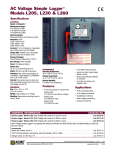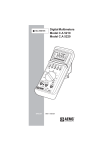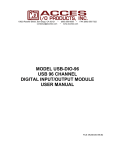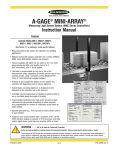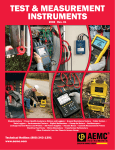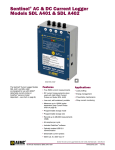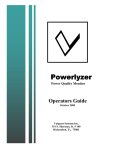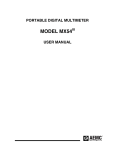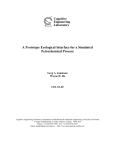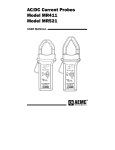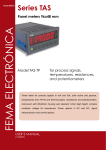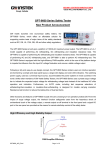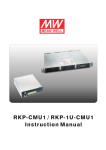Download Selection Guide to Clamp-On Current Probes
Transcript
I1 I2 ▼ Selecting The Correct Clamp-On Current Probe ▼ Selection Guide to Clamp-On Current Probes Answering the following questions will help you to select the appropriate probe for your applications. 4. What type of probe output do you need or can you work with (mA, mV, AC, DC, etc.)? Check the maximum receiver impedance to ensure that the probe will perform to specifications. Other factors you may want to consider: What is the working voltage of the conductor to be measured? AEMC probes must not be used above 600V (see specifications)! What type of output termination do you need: lead with BNC, lead with 4mm safety banana plugs or jacks to accept 4mm leads? Will the probe be used for harmonics or power measurements? Look at the frequency specifications and phase shift specifications. Lastly, if you cannot find information you need or would like assistance, call our application engineers at (800) 343-1391 or fax us at (508) 698-2118, or email [email protected]. Figure 1 Introduction Clamp-on current probes are designed to extend the current measuring capabilities of DMMs, power instruments, oscilloscopes, hand-held scopes, recorders or loggers and other diverse instruments. The probe is “clamped” around the current carrying conductor to perform noncontact current measurements without interrupting the circuit under test. The probe outputs a current or voltage signal directly proportional to the measured current, thereby providing current measuring and displaying capabilities to instruments with low current or voltage inputs. When making a measurement, the current carrying conductor is not broken and remains electrically isolated from the meter input terminals. As a result, the meter’s low input terminal may be either floated or grounded. It is not necessary to interrupt the power supply when using a clamp-on current probe for taking measurements, so costly down time can be eliminated. True RMS measurements within the probe frequency response are possible by using most AEMC current probes with a True RMS multimeter. In most cases, RMS measurements are not limited by Receptor the probes, but by the instrument to which they Production current are connected. Best results are provided by probes offering inherent high accuracy, good frequency response and minimal phase shift. AEMC offers the widest selection of current probes available to measure AC or DC current. Several AEMC probes are patented for their unique circuitry and design and the majority are UL approved. AC Clamp-On Current Probes Theory of Operation An AC clamp-on current probe may be viewed as a variance of a simple current transformer. A transformer (Figure 1) is essentially two coils wound on a common iron core. A current I1 is applied through the coil B1, inducing through the common core a current I2 in the coil B2. The number of turns of each coil and the current are related by N1 x I1 = N2 x I2, where N1 and N2 are the number of turns in each coil. From this relationship: I2 = N1/N2 x I1 or I1 = N2/N1 x I1 This same principle is applied to a clamp-on current probe (Figure 2). The articulated magnetic core holds I1 Conductor/cable N1 I2 ▼ 3. What size conductor will you clamp onto? This parameter determines the probe jaw size needed. Iron core → 2. What is the the maximum current you will measure, and what is the minimum current you will measure? Check that the accuracy at low levels is appropriate, or select a low current measurement probe. Most probes perform with greater accuracy at the upper end of their range. Several probes are designed to measure very low DC or AC. B2 (N2) B1 (N1) ▼ 1. Determine if you are measuring AC or DC (DC current probes are categorized as AC/DC because they measure both). Z A B2 (N2) Probe jaws mA or A range on your instrument Figure 2 Selection Guide to Clamp-On Current Probes (pdf) Technical Assistance (800) 343-1391 www.aemc.com 07/02 1 of 5 the coil B2 and clamps onto a conductor where the current I1 is flowing. B1 is simply the conductor where the user is measuring the current with the number of turns N1 equal to one. The current probe clamped around the conductor provides an output proportional to the number of turns in its coil B2, such that: ▼ A I AC I2 (probe output) = N1/N2 x I1 where N1 = 1 or Probe output = I1/N2 (Number of turns in the probe coil) Figure 3 It is often difficult to measure I1 directly because of currents which are too high to be fed directly into a meter or simply because breaking into the circuit is not possible. To provide a manageable output level multiple turns are set into the probe coil bobbin. ▼ Figure 4 1000A 1000mA (1A) 750A 750mA 250A 250mA 10A 10mA The probe output is connected to a DMM set on the AC current range to handle the probe output. Then, to determine the current in the conductor, multiply the reading of the DMM by the ratio (e.g., 150mA read on the 200mA DMM range represents 150mA x 1000 = 150A in the conductor measured). ▼ Probe Output Conductor (1000 times less or 1mA/A) V AC There are numerous other ratios possible: 500:5, 2000:2, 3000:1, 3000:5, etc. for different applications. The most common application is the use of a current probe with a digital multimeter. Take as an example a current probe with a ratio of 1000:1 (Model SR604) with an output of 1mA/A. This ratio means that any current flowing through the probe jaws will result in a current flowing at the output that is 1000 times smaller: R I The number of turns in the clamp-on coil are generally simple multiples (e.g. 100, 500 or 1000). If N2 equals 1000, then the clamp has a ratio of N1/N2 or 1/1000, which is expressed as 1000:1. Another way to express this ratio is to say that the probe output is 1mA/A - the probe output is 1mA (I2) for 1A (or 1A @ 1000A) flowing in the jaw window. V I DC Figure 5 Current probes may be used with other instruments with current ranges, provided that these instruments have the required input impedance (see Figure 3). Current probes may also have AC or DC voltage outputs to accommodate current measurements with instruments (loggers, scopes, etc.) with voltage ranges only (Figures 4 and 5). This is simply done by conditioning the current probe output inside the probe to provide voltage (e.g., Model MN251). In these cases, the probe mV output is proportional to the measured current (e.g., 1mVAC/AAC). AC/DC Clamp-On Current Probes Theory of Operation (Hall effect) Differing from traditional AC transformers, AC/DC current sensing is often achieved by measuring the strength of a magnetic field created by a current-carrying conductor in a semiconductor chip using the Hall effect principle. When a thin semiconductor (Figure 6) is placed at right angles to a magnetic field (B), and a current (Id) is applied to it, a voltage (Vh) is developed across the semiconductor. This Selection Guide to Clamp-On Current Probes (pdf) Technical Assistance (800) 343-1391 www.aemc.com 07/02 2 of 5 voltage is known as the Hall voltage, named after the US scientist Edwin Hall who first reported the phenomenon. First, since the Hall voltage is not dependent on a reversing magnetic field, but only on its strength, the device can be used for DC measurement. Second, when the magnetic field strength varies due to varying current flow in the conductor, response to change is instantaneous. Thus, complex AC wave forms may be detected and measured with high accuracy and low phase shift. The basic construction of a probe jaw assembly is shown in Figure 7, (Note: one or two Hall generators are used depending on the type of current probe). The many AEMC AC/DC Current Probes were developed based on the above principle, together with patented electronic circuitry incorporating signal conditioning for linear output and a temperature compensation network. These have a wide dynamic range and frequency response with highly accurate linear output, for application in all areas of current measurement up to 1500A. Direct currents can be measured without the need of expensive, power consuming shunts, and alternating currents up to several kHz can be measured with fidelity to respond to the requirements of complex signals and RMS measurements. → • Connect the probe to the instrument. → When the Hall device drive current (Id) is held constant, the magnetic field (B) is directly proportional to the current in a conductor. Thus, the Hall output voltage (Vh) is representative of that current. Such an arrangement has two important benefits for universal current measurement. AC or DC Current Measurement Iron core • Clamp the probe around a single conductor. • Select the function and range. Air gap Conductor Hall generator • Read the conductor’s current value. Example (Figure 8): Figure 7 The probe outputs are in mV (mVDC when measuring DC, and mVAC when measuring AC) and may be connected to most instruments with a voltage input, such as DMMs, loggers, oscilloscopes, hand held scopes, recorders, etc. AEMC also offers different technologies for DC measurements such as in the K100 and K110 designed to measure very low DC currents and using saturated magnetic technology. AC/DC probes also offer the opportunity to display or measure True RMS in AC or AC + DC. AC: Probe Model: MD303 Ratio: 1000:1 Output: 1mAAC/AAC. DMM: Set to mAAC range DMM Reading: 125mAAC Current in Conductor: 125mA x 1000 = 125AAC DC: Probe Model: MR521 1mVDC/ADC (Hall sensor) DMM: Set to mVDC range DMM Reading: 160mVDC Current in Conductor: 160ADC AC: Probe Model: MR411 Output: 1mVAC/AAC (Hall sensor) DMM: Set to mVAC range DMM Reading: 120mVAC Current in Conductor: 120AAC DC: Micro Probe Model K100 Output: 1mVmA DMM: Set to mVDC range DMM Reading: 7.4mVDC Current in Conductor: 7.4mADC Power source Load Id Vh B Figure 8 Figure 6 Selection Guide to Clamp-On Current Probes (pdf) Technical Assistance (800) 343-1391 www.aemc.com 07/02 3 of 5 Low Current, Process Loops, Leakage and Differential Measurements Process Loop I V DC Numerous probes are offered for low current measurements. For example, the Models K100 and K110 have a 50mADC sensitivity and the Model K110 may be used on 4 to 20mA process loops. The selection guide has a special section on low current probes. Figure 9 Examples (Figure 9): 4 to 20mA loop: Probe Model K110 Output: 10mV/mA DMM: Set to mVDC range DMM reading: 135mVDC Loop Current: 13.5mADC (135/10) Figure 10 Power source When the probe is clamped around two conductors with different polarities, the resulting reading will be the difference between the two currents. If the currents are the same, the reading will be zero (Figure 11). When a reading other than zero is obtained, the reading is the amount of leakage current on the load. To measure low currents or leakage, you need a clamp-on probe which will measure low values, such as the Model 2610 (see page 58). Leakage current on grounds also may be measured directly with the Model MN291 (Figure 12). I Load IL ▼ Probe Model: SR604 Ratio: 1000:1 DMM: Set to mAAC range Turns in Probe Jaw: 10 DMM Reading: 60mAAC Current in Conductor: 60mA x 1000/10 = 6000mA = 6A ▼ ▼ When the current to be measured is too low for the probe or better accuracy is required, it is possible to insert the conductor multiple times through the probe jaws (Figure 10). The value of the current is the ratio of the reading to the number of turns. I+IL Motor IL 1 BE 29RENT PRO MACN CUR Figure 11 : UT AC TP /A OU DC MV 100 Figure 12 © 2002 Chauvin Arnoux®, Inc. d.b.a. AEMC ® Instruments Technical Assistance (800) 343-1391 Selection Guide to Clamp-On Current Probes (pdf) www.aemc.com 07/02 4 of 5 Contact Us United States & Canada: Chauvin Arnoux®, Inc. d.b.a. AEMC ® Instruments 200 Foxborough Blvd. Foxborough, MA 02035 USA (508) 698-2115 • Fax (508) 698-2118 www.aemc.com Customer Support - for placing an order, obtaining price & delivery: [email protected] Sales Department – for general sales information: [email protected] Repair and Calibration Service - for information on repair & calibration, obtaining a user manual: [email protected] Technical and Product Application Support –for technical and application support: [email protected] Webmaster - for information regarding www.aemc.com: [email protected] South America, Australia & New Zealand: Chauvin Arnoux®, Inc. d.b.a. AEMC ® Instruments 15 Faraday Drive Dover, NH 03820 USA (978) 526-7667 • Fax (978) 526-7605 [email protected] All other countries: Chauvin Arnoux 190, rue Championnet 75876 Paris Cedex 18, France 33 1 44 85 45 28 • Fax 33 1 46 27 73 89 [email protected] Selection Guide to Clamp-On Current Probes (pdf) Technical Assistance (800) 343-1391 www.aemc.com 07/02 5 of 5






